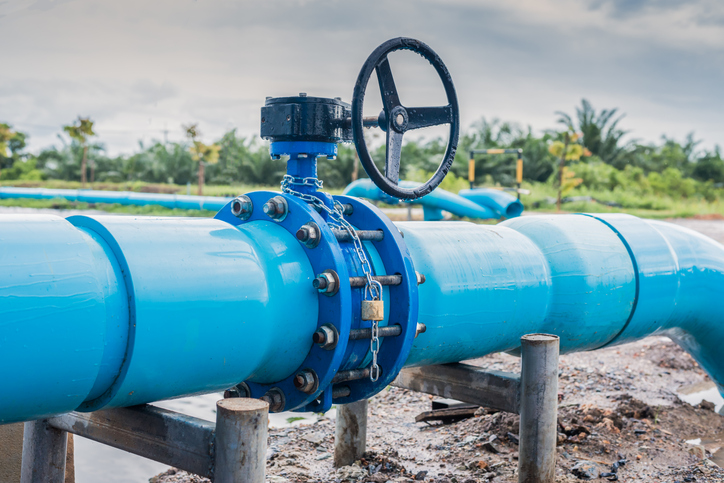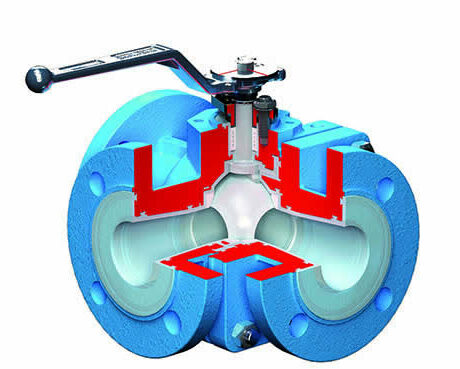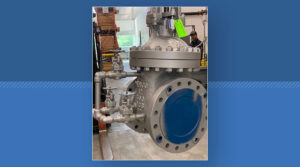Butterfly Valve vs. Ball Valve

When it comes to flow regulation in industrial applications, it is common to have to choose between a butterfly valve or a ball valve. Both are quarter-turn rotary valves that serve similar purposes, but distinct features make them suitable for different situations. In this article, we delve into details of each valve type, compare their features, and provide guidance on choosing between a butterfly valve vs a ball valve.
Features of a Butterfly Valve
A butterfly valve is a quarter-turn valve consisting of a disc that rotates on a shaft in the center of the flow path to control flow. The position of the disc is perpendicular to the pipe flow direction when closed, but when open the disc is parallel to the flow. This design, which requires minimal disc motion, makes butterfly valves suitable for automation and applications with frequent valve operation. The relationship between the valve’s stem position and flow rate is near linear, so butterfly valves can serve in both flow regulation and isolation.
Types of Butterfly Valves

Classification of butterfly valves can be according to its configuration or mounting type. For configuration, it pertains to how the valve disc closes and engages with the valve seal. This ranges from the simplest concentric design to the most complex triple-offset design that provides optimal sealing at high pressures. Mounting of butterfly valves on pipes could be of the wafer type, semi-lug, lug, or double-flanged style. The lug styles offer easy access during maintenance, while the wafer type offers the best resistance at high pressure. Further details on the types of butterfly valves can be found in this article.
Features of a Ball Valve
Unlike a butterfly valve, a ball valve uses a hollow, spherical disc to control flow. When the valve opens, the disc’s hole aligns with the flow, allowing fluids to pass through. Whereas, in the closed position, the ball’s hole rotates to a perpendicular position with the flow, stopping it entirely. Similar to the butterfly valve, a ball valve is a quarter-turn valve, which makes for fast and efficient valve operation as well as automation.
Types of Ball Valves

Ball valves have several types of designs as it pertains to port design.
-
- Full-Port Ball Valve: This valve disc design has a hole that is the same size as the pipeline. As a result, it provides uninterrupted flow with no friction loss.
-
- Reduced-Port Ball Valve: The hole in the ball is slightly smaller than the pipe, which creates some restriction of flow. Also, this valve design increases the velocity of flow and allows for a smaller and lighter ball at a lesser cost.
-
- V-Port Ball Valve: The ball and seat in this design are v-shaped. During operation, the small end of the V opens first, providing a more stable flow. This design is ideal where better flow control is needed or flow velocities are higher as the construction is relatively more sturdy.
-
- Trunnion Ball Valve: Unlike other designs with support only from the top, this design also has support from the bottom. Trunnion ball valves are ideal for high-pressure and large-diameter applications due to the extra support against high loads.
-
- Cavity-Filler Ball Valve: This design is ideal for applications that want to avoid residue staying inside the valve. Cavity-filler ball valves have extended seats that eliminate the presence of any crevices where residue could accumulate. Because, over time or if the fluid running through the valve changes, the presence of such residue could result in contamination. The use of this design is common in applications such as food production and healthcare.
Comparing Butterfly Valves vs Ball Valves
| Feature | Butterfly Valves | Ball Valves |
| Weight | Have lighter weight even at larger pipe diameters. | Becomes significantly heavy at larger pipe diameters and may require support. |
| Size | Suitable for large pipe diameters, even above DN 150. | Weight limits its use to sizes of DN 50 and below. |
| Installation Space | Require smaller installation space. | Installation space is larger than a butterfly valve for the same valve size. |
| Pressure | Associated with significantly more pressure drop. Also prone to leakage in high-pressure applications. | Full port design offers no flow restriction, so pressure drop is insignificant. Excellent seal in high-pressure applications. |
| Maintenance | Have a simpler design with fewer internal parts, so maintenance is typically easier and less expensive. | In contrast, ball valves have more complex internals with multiple components. Hence, maintenance is usually more rigorous and expensive. |
Making the Right Choice Between a Butterfly Valve and a Ball Valve
When deciding between a butterfly valve vs a ball valve for your project, consider the following factors:
-
- Sealing Requirements: If tight shut-off is critical, especially in high-pressure applications, a ball valve is preferable. This is because butterfly valves are prone to leakage and are more difficult to open as pressure increases. When using butterfly valves in high-pressure applications, consider using a bypass valve.
-
- Space Constraints: In applications with limited space, the compact design of butterfly valves could prove more advantageous.
-
- Pressure Drop: If pressure drop across the valve is a big issue, then a full-port ball valve is the go-to option.
-
- Application Specifics: Take into account specific requirements or regulations that govern the application. For example, in food processing and pharmaceuticals where hygiene is important, the smooth crevice-free design of butterfly valves is preferable.
Other Selection Tips
Although there are exceptions to every rule, it is advisable to select a ball valve if:
-
- There is a need for a valve that can effectively handle both liquid and gas media.
-
- The system requires pigging.
-
- The system generates high pressure.
-
- The application requires fast cycle times.
-
- There is a requirement for multi-port flow patterns.
-
- Pipe diameters are small (less than DN 50 or 6 inches).
Whereas, a butterfly valve is preferable if:
-
- The system is handling less pressure.
-
- Pressure drop and leakage do not bear significant risk to the application.
-
- Flow media is water.
-
- The system does not require pigging.
-
- Low setup cost is desirable


